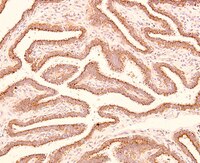Cancer/testis antigens: structural and immunobiological properties.
Kirkin, Alexei F, et al.
Cancer Invest., 20: 222-36 (2002)
2002
Pokaż streszczenie
Characterization of tumor-associated antigens recognized by cytotoxic T lymphocytes which has evolved during recent years opens new possibilities for specific anti-cancer immunotherapy. Among different groups of tumor-associated antigens, cancer/testis (CT) antigens (expressed in many tumors and among normal tissues only in testes) represent the most perspective antigens for immunotherapy because of their broad tumor-specific expression. More than 50 CT antigens have been described so far and, for many of them, epitopes recognized by T lymphocytes have been identified. The most studied group of CT antigens is the MAGE proteins, which form the so-called MAGE superfamily, together with some MAGE-like proteins that have a different distribution than classical CT antigens. The MAGE superfamily includes five families: MAGE-A, MAGE-B, MAGE-C, MAGE-D, and necdin. Comparison of the structure of members of MAGE superfamily points to the existence of a domain organization of these proteins. The central, core domain (second domain) is highly conservative. The first domain is homologous among MAGE family members with a CT expression, but unique for each member of the MAGE-D and necdin families. In addition to the homology of the central domain, the third domain is also homologous among all members of MAGE superfamily, but to a much lesser extent. The MAGE-D proteins contain an additional, fourth domain, which in the case of MAGE-D3 coincides with trophinin, a separate molecule described previously as an adhesion molecule that participates in embryo implantation. The structural classification of the members of MAGE superfamily might help in the future to understand the biological function of MAGE proteins. One important property of the CT antigens is the up-regulation of their expression by DNA demethylating agents, indicating a possible mechanism for their re-expression in tumors. One of the implications of this particular property could be that a combination of immunotherapy targeting CT antigens with chemotherapy inducing up-regulation of CT antigens might result in more efficient tumor eradication. | 11901543
 |










